Almost one-third of consumers use ad blocking extensions when they browse online, which has consequences for the current ad-supported model of the internet. Our new report reveals that people use ad blockers primarily on desktop to improve their user experience browsing online.
As consumers grow fatigued with online advertising, more turn to ad blockers to improve their online browsing experience.
Ad blockers use crawlers to read websites' scripts, blocking ads from users’ view. Research from Statista shows that nearly 1 in 3 computers use at least one form of ad blocker, a number that has doubled since 2014.
Ad blockers, however, disrupt more than just traditional forms of online advertising, such as banner and pop-up ads. They signal a growing fatigue among consumers wearied by the constant presence of advertisements online.
We surveyed 500 people who use an ad blocker plug-in on desktop or mobile to understand:
- Who uses ad blockers
- Why people use ad blockers
- How businesses can effectively advertise to the ad-fatigued consumer
Businesses can use this data to better understand consumer sentiments about online advertising and inform their online marketing and advertising strategies.
Our Findings
- Almost two-thirds of respondents (64%) only block ads on desktop, which increases opportunities for mobile advertising.
- Most people with ad blockers enabled (65%) have used them for at least 1 year, indicating the technology is here to stay.
- More than half of people with ad blockers (56%) are unlikely to click on ads in general.
- Over half of respondents (51%) are most frustrated by video ads that interrupt streaming.
- Nearly half of people (47%) block ads because they interrupt browsing activity.
Ad Blockers are Here to Stay
The earliest ad blockers appeared around 2003, and have grown more popular and sophisticated in the last decade. Technological advances have, in turn, made ad blockers more user-friendly.
Almost two-thirds of respondents (65%) have used an ad blocker for at least one year.
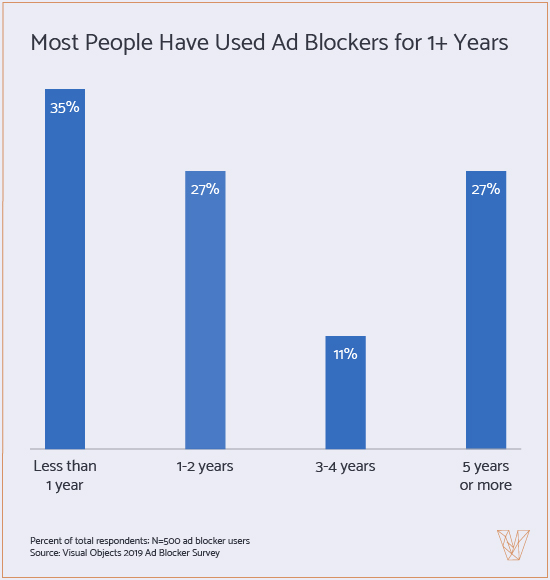
On the higher end, 27% of people have used an ad blocker for at least 5 years. About one-third of people (34%) have used an ad blocker for less than 12 months
Kyle Deming, founder of the web services firm Wojo Design, expressed surprised that many respondents first enabled an ad blocker more than 5 years ago.
“My impression was that [ad blockers] have become popular only recently because users are becoming more tech-fluent," Deming said. "Installing an ad blocker used to be a really tech-savvy move."
Experts believe that ad blockers’ popularity is increasing as the technology becomes more accessible.
“It’s installed by default on most browsers,” said Adam Thompson, a web developer at Fahrenheit Marketing, a full-service digital agency in Austin, Texas.
Google, for example, rolled out its Better Ads Standard in the United States, Canada, and Europe early last year. Working with guidelines established by the Coalition for Better Ads, Google Chrome browsers began removing ads deemed “intrusive," including pop-up and auto-play video ads. The graphic below shows the ads blocked on desktop and on mobile.
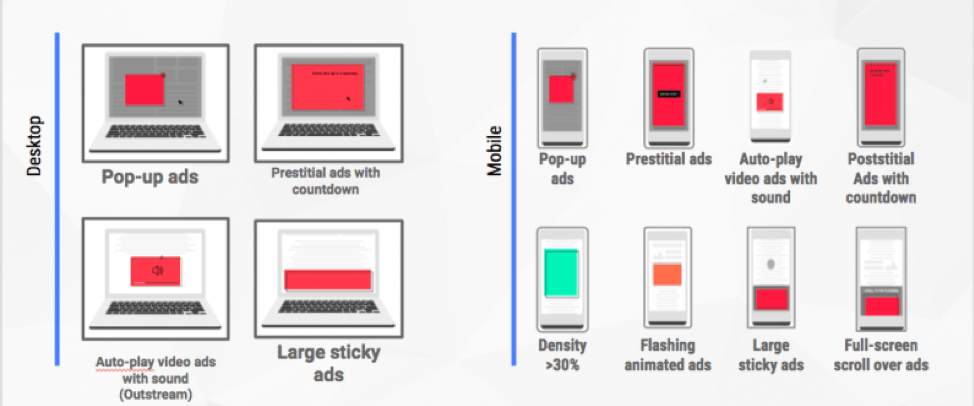
Google plans to introduce this feature on Chrome browsers worldwide on July 9, 2019.
As ad blocking technology becomes more accessible across operating systems, ad blockers will no longer be limited to the tech-savvy. The technology is here to stay, and businesses must diversify their online promotional strategies to avoid alienating ad-fatigued users.
People Block Ads Primarily on Desktops and Laptops
More people enable ad blockers on a desktop or laptop than on mobile phones, indicating opportunities for businesses to advertise on mobile.
Almost two-thirds of people (64%) only use their ad blocker on desktop or laptop computers.
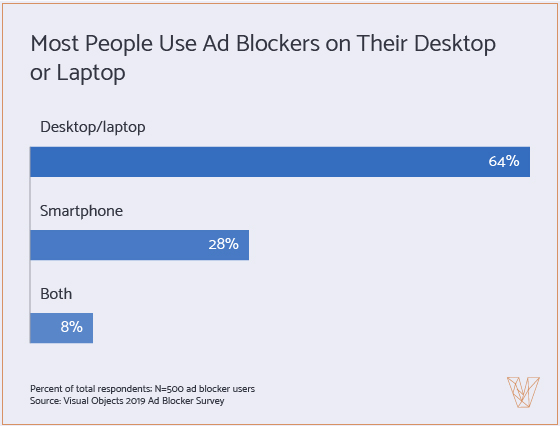
Almost one-third of respondents (28%) use an ad blocker on a mobile device, and only 8% block ads on both mobile and desktop.
Thompson believes the ease of accessing and installing an ad blocker on a desktop browser explains this trend.
“The software is easier to install on a desktop computer than on a mobile device,” Thompson said.
Desktop browsers like Google Chrome make it easier for people to install ad blockers as plug-ins.
In Google’s Chrome Web Store, for example, people can search for ad blockers and choose between several top-rated browser extensions – software programs that allow users to customize their browsing experience.
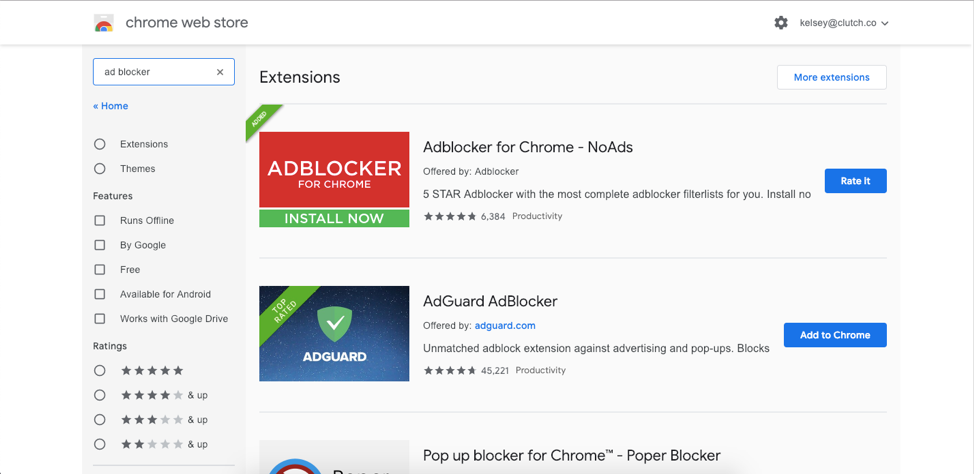
Mobile ad blocking applications exist but are limited in scope. Mobile ad blocking apps only work on mobile web browsers, not in individual apps, like Facebook’s and YouTube’s.
Some, however, believe user demand for an effective, user-friendly mobile ad blocker is growing given the uniquely disruptive nature of online advertising on the mobile web.
“I think the mobile experience is even worse than the desktop experience when it comes to a need for ad blockers,” Deming said. “In the mobile experience you have pop-ups that actually take you to a whole new window, which is far more inconvenient.”
Given how mobile website ads disrupt the overall user experience, many companies choose to advertise to consumers directly through platforms, such as Facebook Ads.
Spencer X. Smith, Founder of AmpliPhi Social Media Strategies, a social media strategy firm in Madison, Wisconsin, says small businesses can benefit from focusing on a platform-first strategy.
“On Facebook, LinkedIn, Instagram, or Twitter, visitors typically access these platforms via an app so the social network controls the experience,” Smith said. “By going directly to the platform, you can avoid being stifled by ad blockers.”
Mobile ads may frustrate consumers, as they disrupt the mobile user experience and are harder to block on individual apps and platforms.
To target an increasingly mobile consumer base, businesses should prioritize ad spending on platforms directly.
Poor User Experience Drives Ad Blockers
People use ad blockers to improve their user experience when browsing online. Traditional online advertisements such as banner ads or pop-ups slow or disrupt users looking for valuable content online.
Almost half of people (47%) mainly use ad blockers because ads interrupt or slow their activity online.
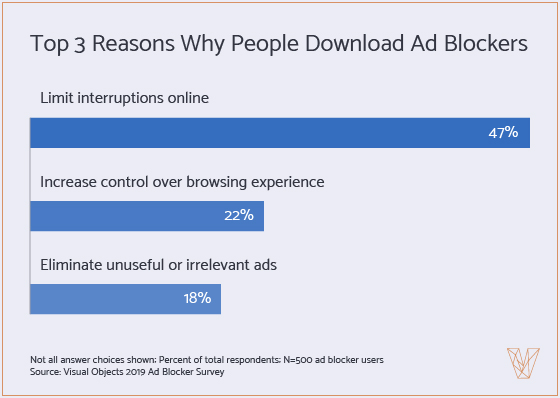
Other reasons include wanting more control over their browsing experience (22%), avoiding un-useful or irrelevant ads (18%), and feeling uncomfortable about ads that show products from users' browsing history (12%).
The online advertisements targeted by ad blockers use scripts, or pieces of code that direct commands within a website, that ultimately disrupt the user experience by slowing down the website. One 2017 study found that 40% of online ads are “overweight,” or full of media and animation that slows websites down.
Deming explains that the number and “weight” of ads contributes to a poor user experience.
“The sheer volume of ads will actually impact the website experience, particularly the loading time or even functionality,” Deming said. “You see many websites, especially ones driven by advertising revenue, with 30 to 45 scripts installed that bring the website to a crawl.”
Image-rich banner ads like the one from The New York Times’ homepage, shown below, require additional time to load.
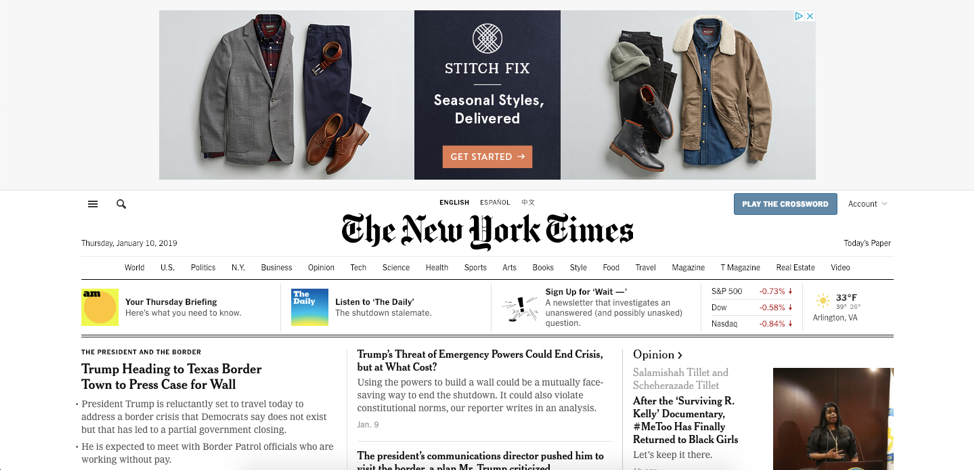
Banner ads also distract readers from the content on the page, which is the primary reason why people visit a website.
Businesses should limit these types of ads to maintain a fast and pleasant user experience.
Ad Blockers Have Unintended Consequences for Businesses
Even though most people who use ad blockers believe ads disrupt their user experience, it’s important to recognize that ad blockers affect businesses' websites in unexpected ways.
Ad blockers sometimes block non-promotional elements of websites from loading or functioning because of development flaws.
For example, the company’s blog shown below fails to load written content until the reader disables their ad blocker. The image below shows the blog post page before (left) and after (right) the ad blocker has been disabled.
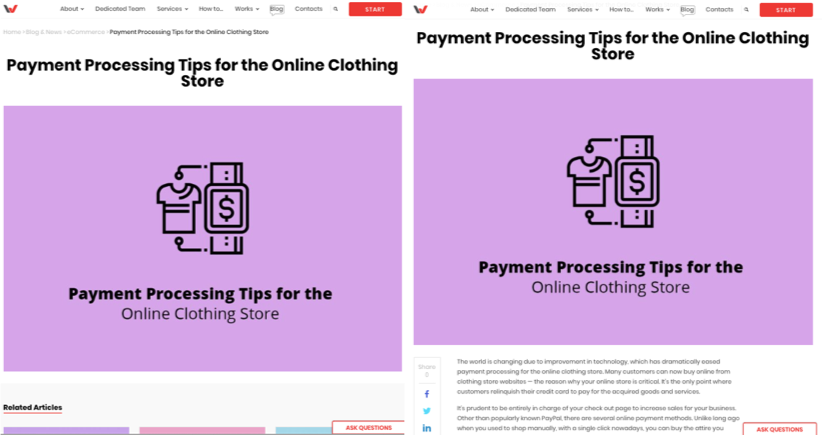
Adam Thompson works with businesses to ensure they don’t include website features that inadvertently trigger ad blockers.
“[Businesses] need to be aware of ad blockers and code their websites so things that need to display don’t trigger the ad blocker,” Thompson said.
Ad blockers disrupt the user experience of larger websites as well. When users enable ad blockers on The New York Times’ website, for example, large gray spaces replace the ads. This effect offers only a marginal improvement to the overall user experience.

The New York Times, like many other news outlets that rely on ad revenue, employs strategies that encourage users to “whitelist” them by temporarily disabling their ad blocking tools.
Deming has seen small businesses mimic this strategy, which relies on deliberately disrupting the website user experience to coerce users into whitelisting a site.
“A lot of sites are taking more aggressive measures to disable or discourage ad blockers,” Deming said. “A lot of websites . . .really won’t function with an ad blocker.”
Though Deming says some businesses coerce users with ad blockers to whitelist their website, he cautions against the practice when working with clients.
“Our recommended approach is to be more user-friendly and ask politely.” Deming said.
It may be tempting for businesses to limit their website’s functionality when ad blockers are present, but it’s not worth the potential frustrations for the users.
It's important for businesses to work with web developers to ensure their websites avoid triggering ad blockers by mistake.
Video Ads Lead the Top 3 Most Frustrating Ads
People encounter video ads the most frequently, but these ads prove a particular nuisance for people who enable ad blockers.
Over half of respondents (51%) say they are most frustrated by some type of video ad. This statistic includes both videos that appear before content loads (21%) and ones that interrupt streaming (30%).
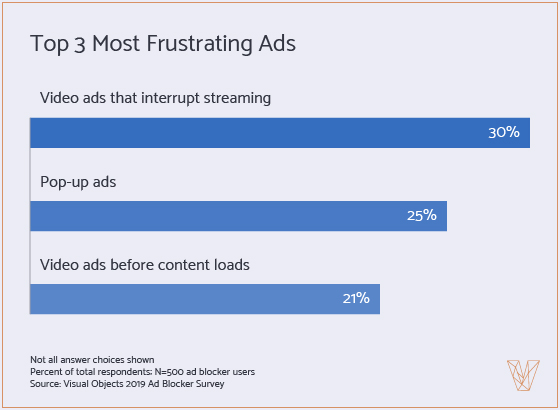
Videos that start automatically when someone visits a page are particularly intrusive, sometimes with embarrassing consequences for a website's users.
“That’s a level of intrusion that goes way beyond almost any other type of ad experience,” Deming said
Users’ frustration affects businesses that host video ads on their websites or use video ads elsewhere on the internet to promote their offerings.
Video is a dynamic and popular alternative to traditional, long-form blog content, but businesses need to keep user experience in mind when incorporating video on their websites. Auto-play videos frustrate consumers, and videos should not be interrupted by ads.
Moz, marketing analytics software company, uses video to enhance its Whiteboard Friday content without disrupting the user experience, as shown below.
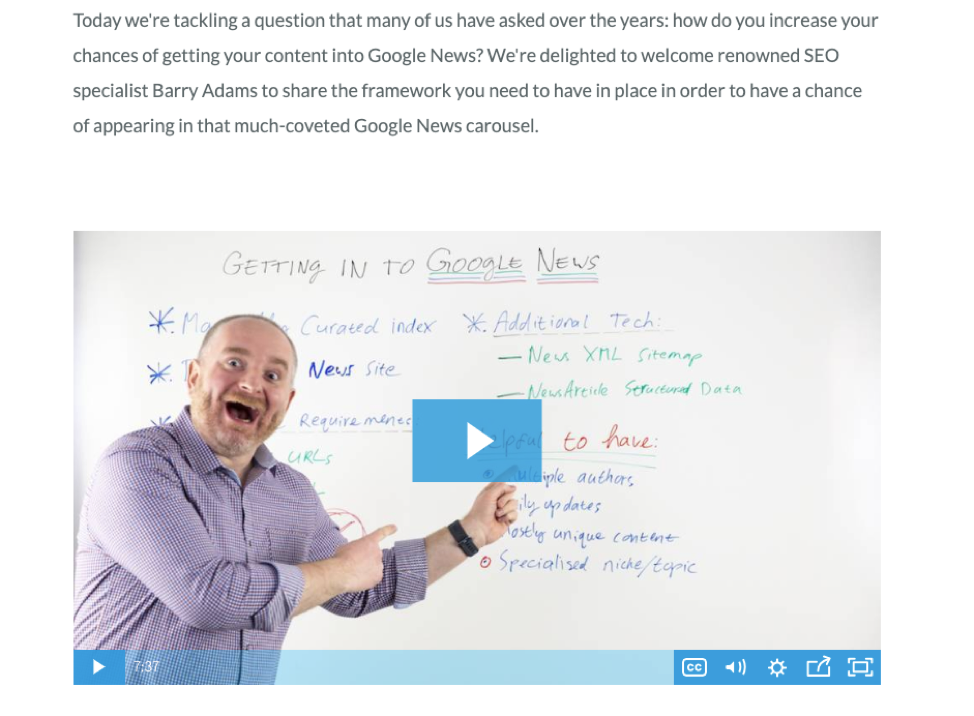
An ad-free video greets the reader at the top of the article, giving them the choice to click play or continue scrolling to the transcript.
Video ads frustrate people with ad blockers the most, so businesses should use caution when including videos on their websites.
People Who Enable Ad Blockers Are Less Likely to Click Any Ads
Innumerable ads on the internet make people weary. Those who have taken the extra step and downloaded an ad blocker are now even more unlikely to click on the ads that they do see.
More than half of people (56%) said they are unlikely to click any online ads.
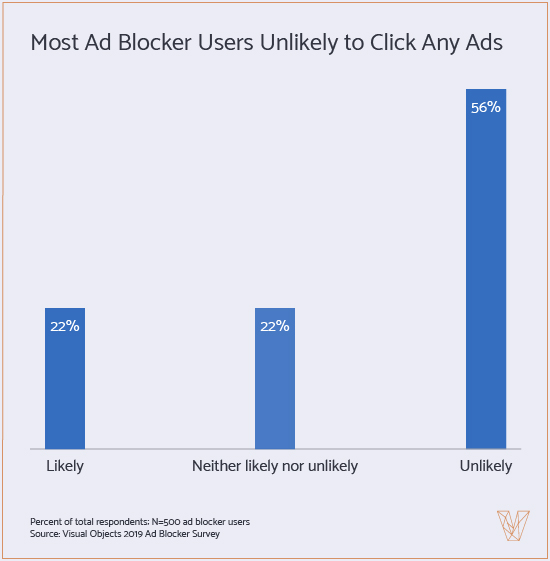
This means that even someone who only uses an ad blocking tool on one device is less likely to click on ads altogether.
This challenges businesses that wish to market to the tech-savvy crowd that's more inclined to use ad blockers.
Robb Hecht, an adjunct professor of marketing at Baruch College in New York City (CUNY), recommends businesses prioritize content and user experience when marketing to this subset of consumers.
“Customers today are not looking to be marketed at, they are looking to have personalized digital experiences addressing their problems or needs,” Hecht said. “A content strategy backed up by predictive, AI-backed personalization tools will make the current age of ads look outdated."
“Brands build trust with customers by embracing their user-generated content and by providing integrated offline brand experiences; in this way users become customers.”
Hecht says a content strategy that's tailored to individual consumers can entice ad blocker users to limit the advertising content they encounter.
Some businesses use alternative channels to market to engaged, tech-savvy consumers in ways that enhance, rather than disrupt, the overall user experience online.
Spotify, for example, now offers sponsorship options for its popular ‘Discover Weekly’ playlist. This playlist is customized to every unique listener’s personal tastes based on information listeners offer about their preferred artists and genres.

Spotify looks to monetize this feature by allowing brands to sponsor a weekly playlist based on information collected about listeners.
Spotify insists that their branded playlists won’t interfere with Discover Weekly’s user experience, hoping that the engaged, trusting subset of users will respond positively to this new form of advertising.
Businesses should focus their advertising efforts on personalizing digital experiences and creating value with their advertising content.
Businesses Should Be Aware of Ad Blocking Consumers
Businesses should be aware of the growing number of people using ad blockers online. People primarily block ads on desktops and laptops and ad blockers are more frequently installed by default on many browsers.
People turn to ad blockers to improve their online user experience and use ad blockers to combat the disruptive ads that slow pages' loading times. People say the ads they see the most frequently are the most frustrating, namely video ads that interrupt streaming or that appear before content loads.
Ad blockers may have other, unintended consequences for businesses. They may read certain elements of code as disruptive and block functionality that isn't advertising on websites. Businesses should work with web design companies and developers to make sure they are not accidentally blocking non-promotional content.
People with ad blockers are less likely to click on ads overall. In response, businesses should diversify their digital marketing strategies to include advertisements that add value to their target audience. Doing so will build trust with ad-weary consumers.
About the Survey
Visual Objects surveyed 500 people from the U.S. who use ad blockers when browsing online. Sixty-five percent (65%) are female, and 35% are male.
Survey respondents varied in age: 18% of respondents are 13-24; 30% are 25-34; 17% are 35-44; 15% are 45-54; 12% are 55-64, and 8% are 65 and over.
Respondents are from the Midwest (22%), Northeast (16%), South (36%), and West (23%).